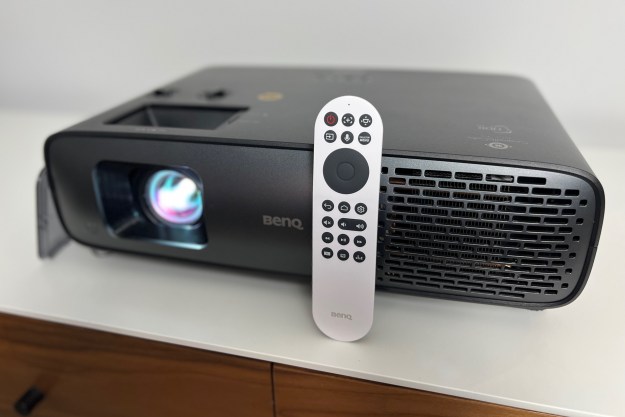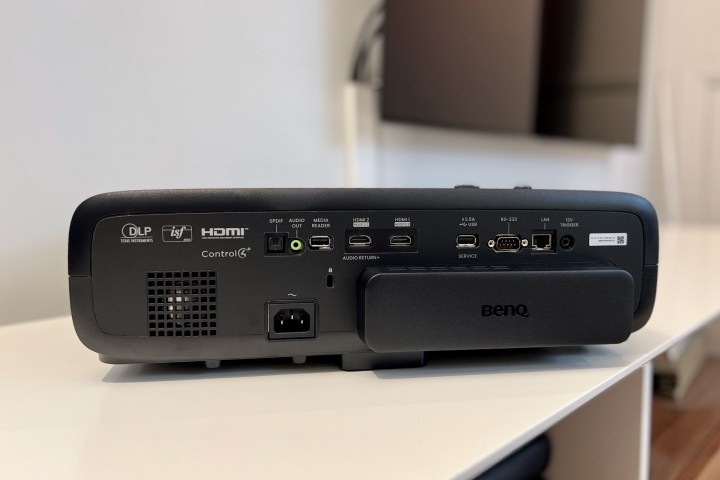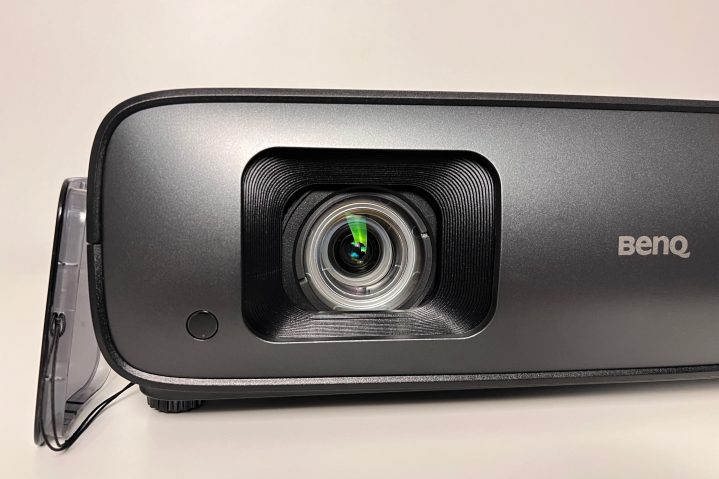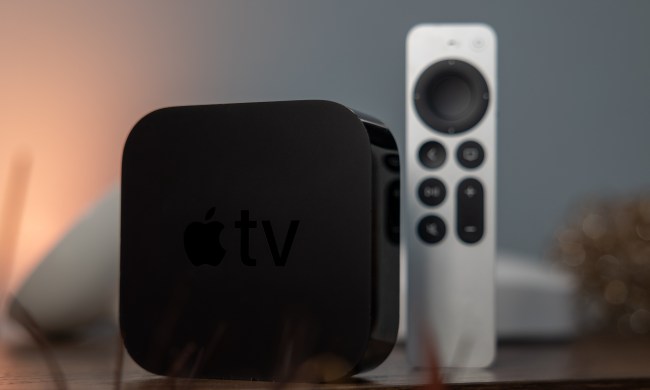
“The BenQ HT4550i 4K projector is calibrated out of the box, but it gets even better with a few tweaks.”
- Amazingly accurate color
- Bright 3,200 ANSI lumens image
- HDR modes for days
- Comes with Android TV
- Vertical/horizontal lens shift is excellent
- The fan is quiet
- Built-in sound isn’t great
- Black levels suffer a bit in light rooms
BenQ’s premium-level home theater projector, the HT4550i 4K HDR LED, does not disappoint. Designed for “AV content fanatics and movie aficionados,” the HT4550i sits at the top of BenQ’s offerings for 2023 thanks to 4K UHD (3,840-by-2,160) resolution, impressively bright 3,200 ANSI lumens, and Android TV built-in (well, sort of).
The upgraded follow-up to BenQ’s popular HT3550, the HT4550i holds its own in moderately bright rooms — as it should at a cost of $2,999 — thanks to its solid-state LED light source. But it’s no surprise that it excels in the dark, where its exclusive HDR-Pro (with HDR10+ support) and CinematicColor tech that allows for 100% DCI-P3 color coverage pump out respectable black levels and beautifully accurate color that is factory-calibrated and out-of-the-box ready.
Beyond the box, though, the HT4550i has adjustable picture settings for days, allowing users to dial in their perfect image with ease. And it didn’t take long to turn my modest basement into a gobsmacking home theatre, either. The HT4550i is easy to move around during setup, thanks in part to its vertical/horizontal lens shifting and other image-fitting features.
But is it worth the three-grand price tag when you could get into an ultra short throw or laser projector in that same ballpark? Let’s find out.
Setup

Setting up a projector — especially one in this price range that’s meant for more dedicated home theater setups — can be intimidating. And while things like placement distance and height, as well as keystone and focus adjustments, need to be taken into consideration with any projector, going from unboxing to showtime with the HT4550i is pretty straightforward.
The included quick-start guide includes a helpful distance-to-screen chart for figuring out where it should be placed in a wide range of room sizes. For example, while the chart has measurements for an image size as small as 30 inches, BenQ recommends a minimum 60-inch image, with the projector at a minimum distance of around 5 feet. On the maximum end, it recommends a 200-inch image at a distance of around 16 feet. I projected a 100-inch image on a 16:9 screen and placed the HT45501 about 9.5 feet away.
The BenQ HT 4550i has a 0% to -60% vertical lens shift and a +/- 15% horizontal lens shift, which means that you have some leverage for moving your image left, right, and up and down to perfectly align it to the screen using the manual shift dials on top of the unit. I did notice that while shifting the image vertically to fit my screen, the image skews slightly up and to the right, requiring you to adjust the projector’s position to compensate. It’s not a big deal, but worth noting. The HT4550i’s manual 1.3x zoom and manual focus allow for easy size adjustment, fine-tuned fitting, and focusing, which I actually prefer over automatic focus.
The HT4550i also has auto 2D vertical keystone adjustment and manual horizontal keystone adjustment, but because I measured things out correctly and adjusted the shift myself, there was little or no keystone adjustment needed (if it did it automatically, I didn’t notice). This is actually the ideal situation you want, as too much keystone adjustment can potentially skew the image.
- 1. The installed Android TV dongle
- 2. The quick-start guide, remote, and Android TV dongle
- 3. Focus, zoom, and manual shift controls
The HT4550i (the “i” signifies its focus on streaming content, BenQ says) has two HDMI 2.0 inputs (with eARC support) for connecting a range of sources, from Blu-ray players to streaming devices like Apple TV or Roku, but it does come with its own
Setting up the Android TV interface is standard, and it comes with Netflix and several other
The unit itself is made of sturdy plastic with a sleek matte finish and measures 16.54 by 5.31 by 12.28 inches, and there’s a tethered, snap-in lens cover and a slide-over cover for the focus and zoom dials, all to help keep dust at bay. Lastly, the HT4550i comes with a remote that controls both the projector and the
Brightness, color, and HDR

The BenQ 4550i uses the company’s 4LED light source that boasts 3,200 ANSI lumens of brightness, which is impressively bright for an LED projector, especially one in this price range. BenQ says that the 4550i is “specially designed for moderately dark AV rooms,” and it’s right on the money.. The HT4550i’s image brightness blew me away when the lights went down, creating an excellent viewing experience that’s so clear that I had to compare it to my LG OLED for reference. Driving that clarity is a Texas Instruments 0.66-inch DLP
The HT4550i projector uses BenQ’s new CinematicColor DCI-P3 tech to deliver what BenQ says is accurate enhanced colors. When the projector is in
Performance and picture modes

All the specs and big numbers aside, the picture on the HT4550i is absolutely gorgeous. In my experience, a 100-inch image in my small-to-medium-sized basement TV room was perhaps a bit big for the space, but its clarity, color, and dynamic contrast made for an excellent viewing experience with movie-theater impact, whether watching SDR or
The HT4550i offers a wide range of picture modes that are well-calibrated and look great out of the box without any adjustments at all, which is great if you’re new to the projector world. But should you want to tweak things, the level of available fine-tuning you can do with this projector is off the charts.
For testing out SDR movies, I used my Apple TV 4KK, dropping the resolution down to SDR 1080p in the device’s settings. I then threw on some scenes from Pulp Fiction and The Hangover on Netflix. Picture modes for SDR include Bright, Bright Cinema, Cinema, Filmmaker Mode, and User. For the screen, I used a mid-priced, 100-inch matte white screen with a 1.1 gain reflection, but if you were going to get a bit more serious, you could go for a premium screen like Elite Screens’ Aeon Series CineWhite fixed frame screen with a 1.3 gain, which would add even more brightness.
Although BenQ recommends Filmmaker mode for SDR content (this automatically activates the WCG feature) to achieve the 100% Rec.709 gamut, I actually preferred the Bright Cinema mode. Turning off the WCG, as it turns out, also bumps up the brightness, so I opted to leave this off. For both movies, I found the color, brightness, and contrast to be good, and in Pulp Fiction, Jules and Vincent’s black-and=white suits popped, and the light from the window in the hallway as they talk about foot massages is nice and clean, too.
I didn’t see a big difference between any of the other picture modes except Bright, which has a noticeable green tinge — I assume it’s meant to be manually tweaked. There are also several Light Source Modes that affect brightness and the strain on the bulb. For the most part, I used the Normal mode, as I found it to be the brightest. SmartEco and Eco mode were very similar – slightly dimmer than Normal — but Eco mode significantly quieted up the projector’s fan.
Whether using the
- 1. A scene from Avengers Endgame, in a dark room
- 2. A scene from The Witcher with some light in the room
- 3. Thanos, from Avengers. Endgame
- 4. Another scene from The Witcher
- 5. A scene from Game of Thrones’s The Long Night episode
- 6. A scene from Game of Thrones’s The Long Night episode
I watched everything from Avengers: Endgame on Disney+ and The Witcher on Netflix to Game of Thrones on HBO (for HDR10 examples) and The Tomorrow War on Amazon Prime Video for the tone-mapped HDR10+ source, and switched back-and-forth between the Apple TV and the
For my HDR10 test with Endgame and GoT, in a dark room, I switched between it and Filmmaker Mode, the latter of which shows off the WCG’s super-accurate colors and skin tones (Thanos was indeed Thanos purple). Like with my SDR tests, I did prefer the image with the WCG filter off for that extra brightness bump, especially when putting GoT’s much-criticized The Long Night episode to the test. The dark scenes were indeed dark, but I could see all the details just fine (Jon Snow fumbling around in the dark killing walkers, the Night King in all his glory). Although the color with the Wide Color Gamut feature on is admittedly better, I didn’t see enough of a difference for me to choose it over the extra brightness.
In HDR10+ through the
The bottom line
The BenQ HT4550i may seem daunting for the uninitiated (and due to its $3,000 price), but for a premium LED DLP projector that can turn most medium-sized rooms into an impressive
But perhaps what is most appealing about the HT4550i is how ready to roll it is out of the box. It’s nearly perfect at the get-go, but offers you the ability to easily tweak a wide range of settings via advanced color settings to tailor it to your room and your preferences, which gives the HT4550i a leg up on cheaper — and even some higher-end — projectors. Plus, even if you don’t have your own streaming device or Blu-ray player to get started with, the included
The HT4550i could also give some laser projectors and multi-chip DLP projectors a run for their money in brightness and price. For some comparisons, you could check out BenQ’s own X3000i 4K gaming projector, which shares many of the same features (including its 4LED light source and 100% DCI-P3 CinemaColor), but not HDR10+ support, for $1,000 less, and even the Epson EpiqVision LS800 UST an ultra-short throw (UST) 4K laser projector with 4,000 ISO lumens of brightness that costs $3,500.
But with its video quality, ease of use and setup, and piles of adjustable features, it’s worth considering forking over $3,000 for the BenQ HT4550i.













